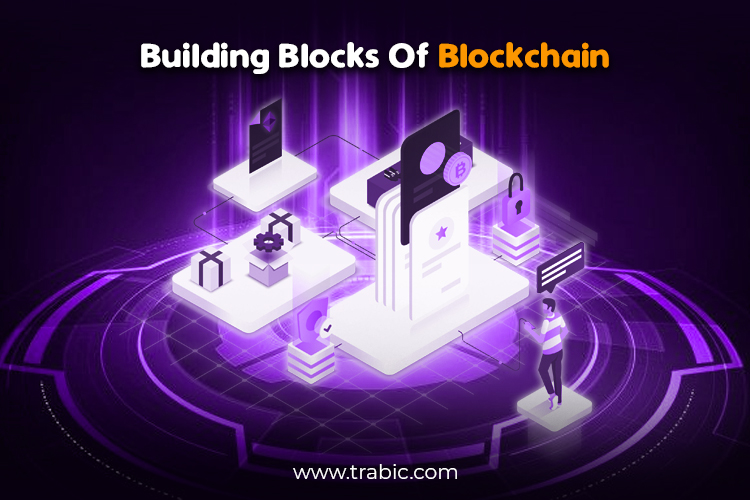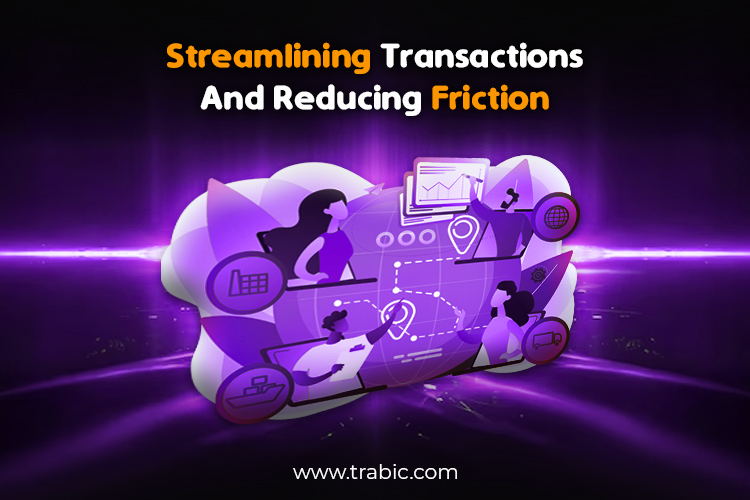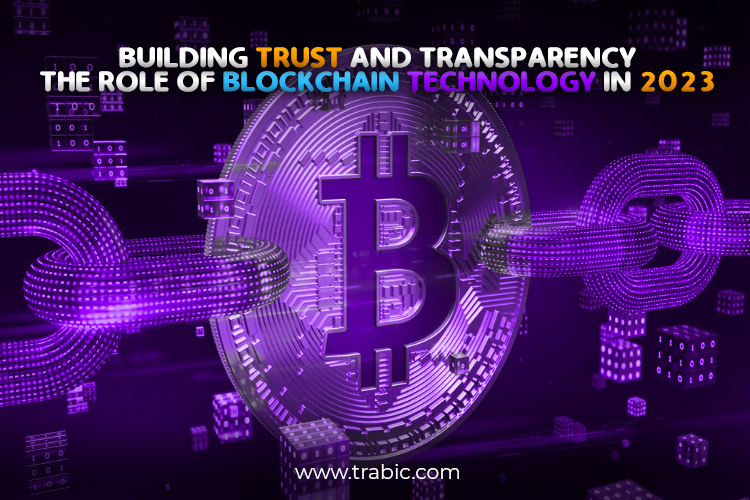In this exciting era of digital innovation, blockchain has emerged as a powerful force, revolutionizing industries and reshaping how we conduct business. It’s time to dive into the incredible potential of blockchain and discover how it’s building a secure and transparent digital world.
In today’s rapidly evolving digital landscape, where data breaches, fraudulent activities, and privacy concerns are prevalent, trust and transparency have become critical elements for businesses and individuals. Enter blockchain technology, which has emerged as a transformative force, revolutionizing various industries by offering unparalleled security, immutability, and decentralization. As we delve into 2023, the role of blockchains in building trust and transparency in the digital world has gained even more prominence. This blog explores how blockchains reshape industries and foster a new era of trust and transparency.
The Fundamentals of Blockchain Technology:
At its depth, blockchain is a decentralized, distributed ledger that records transactions across multiple computers. Unlike traditional databases that rely on a central authority, blockchains distribute data and processing power across a network of participants, ensuring transparency and security. Each transaction is grouped into a block, cryptographically linked to the previous block, forming an immutable information chain.
Building Trust through Immutability
One of the foundational aspects of blockchains is immutability. Once an action is recorded on the blockchain, it becomes virtually impossible to alter or manipulate. This feature creates a trust layer, eliminating the need for intermediaries or third parties to verify and authenticate transactions. Blockchains have emerged as a game-changer in supply chain management, real estate, and finance industries, enabling transparent and tamper-proof records. Companies can leverage blockchain technology to track the provenance of goods, verify authenticity, and ensure compliance with regulatory standards, all of which contribute to building trust among stakeholders.

The fundamentals of blockchain technology are crucial to understanding its transformative potential in building trust and transparency in the digital world. Let’s explore the key aspects:
- Decentralization: Unlike traditional centralized systems where data and authority are controlled by a single entity or a small group, blockchain technology operates on a decentralized network. It consists of multiple nodes (computers) distributed across the network, each maintaining a copy of the blockchain’s entire transaction history. This decentralized nature eliminates the need for intermediaries, such as banks or governing bodies, and empowers participants to validate and record transactions collectively.
- Distributed Ledger: At its core, blockchain technology is a digital ledger that records transactions. This ledger is distributed across all nodes in the network, ensuring that each participant has a copy of the same information. Every transaction is grouped into a block and added to the chain chronologically. The distributed ledger provides transparency, as all participants can view and verify the transactions, eliminating the need to trust a central authority.
- Immutability: Once an action is recorded on the blockchain, it becomes nearly impossible to alter or delete. Each block contains a unique cryptographic hash, a digital fingerprint of the data within the block. Each subsequent block’s hash includes the previous block’s hash, creating a chain that links all the blocks together. Any attempt to tamper with a transaction in a previous block would require altering the subsequent blocks, rendering the alteration evident. This immutability ensures the integrity and trustworthiness of the data recorded on the blockchain.
- Consensus Mechanisms: Consensus mechanisms are employed to maintain the integrity of the blockchain. Consensus mechanisms enable the nodes in the network to accept the validity of transactions and the order in which they are added to the blockchain. Popular consensus mechanisms include Proof of Work (PoW), where participants compete to solve complex mathematical problems to validate transactions, and Proof of Stake (PoS), where validators are chosen based on the amount of cryptocurrency they hold. These mechanisms ensure that transactions are agreed upon by most participants, preventing fraudulent activities and maintaining the security of the blockchain.
- Cryptography: Blockchain relies on cryptographic algorithms to secure and protect the data recorded on the network. Public key cryptography generates pairs of cryptographic keys: public and private keys. The public part is shared openly, while the private key is kept secret. Transactions on the blockchain are digitally signed using the private key, and the signs can be verified using the corresponding public key. This cryptographic layer ensures the authenticity, confidentiality, and integrity of the transactions and participant identities on the blockchain.
By combining decentralization, a distributed ledger, immutability, consensus mechanisms, and cryptography, blockchain technology provides a secure, transparent, and trustworthy infrastructure for various applications. Its potential reaches far beyond cryptocurrencies, enabling industries to build systems that enhance trust, streamline processes, and foster transparency in the digital world.
Upgrading The Security and Privacy Measures:

Blockchains employ advanced cryptographic techniques to secure data, making it extremely resistant to unauthorized access or tampering. The decentralized nature of blockchains eliminates single points of failure, reducing the risk of hacking and data breaches. As privacy concerns grow, especially with the increasing digitization of personal information, blockchain technology offers the potential to address these issues. Through techniques like zero-knowledge proofs and decentralized identity management, individuals can control their data while selectively disclosing information as needed.
Streamlining Transactions And Decreasing Friction:
Traditional transactions often involve intermediaries like banks to facilitate and authenticate transactions. These intermediaries can introduce delays, costs, and potential vulnerabilities. By leveraging blockchain technology, transactions can be streamlined, removing the need for intermediaries and reducing friction. Smart contracts, self-executing agreements embedded in the blockchain, automate the execution and enforcement of contractual terms, minimizing human intervention and increasing efficiency. This transparent and automated approach enhances trust among participants, allowing for seamless transactions in various sectors, including finance, supply chain, and intellectual property rights.

Let’s delve into how blockchain achieves these objectives:
- Immutable and Tamper-Resistant: The immutability of blockchain technology ensures that once an action is recorded on the blockchain, it cannot be altered or deleted without the consensus of the network participants. Each block in the chain is linked cryptographically to the previous block, making it computationally infeasible to modify past transactions. This immutability protects the integrity of the data and prevents unauthorized tampering, enhancing security.
- Distributed and Decentralized Network: Blockchain technology operates on a distributed and decentralized network of nodes, which alleviates the hazard of single points of failure and unauthorized access. In traditional centralized systems, a single breach can compromise the entire system. Still, in a blockchain network, an attacker must simultaneously compromise most nodes, making it highly resistant to hacking attempts. The distributed nature of blockchain ensures that no single entity controls the network, reducing the risk of data breaches.
- Encryption and Cryptography: Blockchain technology employs advanced cryptographic techniques to protect the confidentiality and integrity of data. Each participant on the blockchain has a unique cryptographic key pair containing a public key and a private key. Transactions are encrypted using the sender’s private key and can only be coded using the recipient’s public key. This encryption ensures that sensitive information remains confidential and inaccessible to unauthorized parties.
- Permissioned and Permissionless Blockchains: Blockchain technology networks can be either permissioned or permissionless. In permissioned blockchains, access to the network is restricted to a predefined set of participants, ensuring greater control and privacy. Permissioned blockchains are suitable for industries with regulatory requirements or sensitive data. On the other hand, permissionless blockchains, such as public cryptocurrencies, allow anyone to participate in the network while maintaining pseudonymity. Participants can transact without revealing their real-world identities, providing privacy.
- Self-Sovereign Identity: Blockchain technology enables self-sovereign identity, where individuals have control over their personal information and selectively disclose it as needed. Instead of relying on centralized identity systems, individuals can store their identity credentials on a blockchain, granting them control and ownership. This decentralized identity management enhances privacy by reducing reliance on centralized authorities and minimizing the risk of identity theft or data breaches.
- Zero-Knowledge Proofs: Zero-knowledge proofs (ZKPs) are cryptographic protocols that allow one party to prove the validity of a statement without revealing any other information beyond the statement’s truthfulness. ZKPs enable privacy-preserving transactions and verifications on the blockchain. For example, users can prove they are over 18 without disclosing their exact age or revealing other personal information.
By combining immutability, distributed networks, encryption, self-sovereign identity, zero-knowledge proofs, and more, blockchain technology enhances security and privacy in the digital world. It provides individuals and businesses with a robust framework to protect sensitive information, prevent unauthorized access, and maintain confidentiality, ultimately fostering trust in digital transactions and interactions.
Facilitating Auditing and Regulatory Compliance:
Blockchain technology’s inherent transparency and immutability provide an unprecedented opportunity for auditing and regulatory compliance. In industries with stringent regulations, such as finance and healthcare, blockchain technology offer a reliable mechanism to track and verify compliance. Auditors can access a real-time, auditable trail of transactions, enabling them to identify discrepancies or fraudulent activities quickly. This transparency also empowers regulators to monitor industries effectively, ensuring fair practices, consumer protection, and market integrity.
“Facilitating Auditing and Regulatory Compliance” refers to enabling and supporting organizations in meeting the requirements set forth by auditing and regulatory bodies.
Auditing involves systematically examining and verifying an organization’s financial records, processes, controls, and procedures. It ensures that the organization’s financial statements and operations are accurate, reliable, and compliant with relevant laws, regulations, and accounting standards. Auditing provides independent assurance to stakeholders, such as shareholders, investors, and the general public, regarding the organization’s financial health and adherence to applicable regulations.
Regulatory compliance, on the other hand, refers to adhering to the laws, rules, and regulations that govern a particular industry or sector. Governmental authorities, industry-specific agencies, or professional bodies can impose these regulations. Compliance is crucial to ensure ethical practices, protect consumers, maintain data privacy, promote fair competition, and mitigate financial, environmental, health, and safety risks.
Facilitating auditing and regulatory compliance involves implementing processes, systems, and practices that make it easier for organizations to meet these requirements. Here are some key aspects:
- Documentation and Record-Keeping: Maintaining accurate and organized records is essential for audits and compliance. This includes financial statements, transaction records, contracts, policies, procedures, and other relevant documentation.
- Internal Controls: Establishing robust internal control mechanisms helps organizations mitigate risks, prevent fraud, and ensure compliance. These controls include segregation of duties, approval processes, access controls, and regular monitoring and reporting.
- Compliance Programs: Developing and implementing compliance programs tailored to the specific regulatory requirements of the industry. These programs include policies, procedures, training, and monitoring mechanisms to ensure relevant laws and regulations adherence.
- Risk Assessment: Conduct regular assessments to identify potential compliance risks and vulnerabilities. This enables organizations to prioritize and address areas requiring attention, reducing non-compliance likelihood.
- Technology and Automation: Blockchain solutions and automation tools can streamline auditing and compliance processes. This includes financial management software, enterprise resource planning (ERP) systems, data analytics tools, and electronic document management systems.
- External Audit Support: Collaborating with external auditors to provide necessary information, access to records, and assistance during the auditing process. This involves maintaining open communication and addressing any identified issues or recommendations.
- Regulatory Monitoring: Keeping track of changes in regulations, standards, and industry practices to ensure ongoing compliance. This includes staying updated with new laws, guidelines, and reporting requirements and adjusting internal processes accordingly.
Organizations can demonstrate their commitment to transparency, accountability, and ethical business practices by actively facilitating auditing and regulatory compliance. It also helps build trust with stakeholders, mitigate legal and reputational risks, and promote a culture of compliance within the organization.
“Empowering Decentralized Systems and Governance” refers to enabling and supporting the implementation and operation of decentralized systems and governance models.
Decentralization involves distributing authority, decision-making power, and control away from a central authority or governing body. Instead, power is distributed among multiple participants or nodes, allowing for more equitable and transparent systems. Decentralized systems are typically built on distributed ledger technologies, such as blockchain, enabling secure and transparent record-keeping and transaction verification.
Empowering decentralized systems and governance involves several key principles and elements:
- Distributed Decision-Making: Decentralized systems aim to involve multiple stakeholders in decision-making processes. Instead of relying on a central authority, decisions are made collectively through consensus mechanisms, voting systems, or community governance models. This ensures that decisions reflect the interests and perspectives of a broader set of participants.
- Transparency and Accountability: Decentralized systems prioritize transparency by making information, data, and transactions accessible to all participants. This transparency helps maintain participant accountability and reduces the potential for fraud or manipulation.
- Trust and Security: Decentralized systems leverage cryptography and consensus algorithms to ensure the security and integrity of data and transactions. By distributing data across multiple nodes and using consensus mechanisms, decentralized systems reduce the risk of single points of failure and unauthorized manipulation.
- Tokenization and Incentives: Many decentralized systems utilize tokens or digital assets as a means of value exchange within the ecosystem. These tokens often incentivize participants to contribute resources, provide services, or maintain the network. Tokenization helps align the interests of participants and can facilitate decentralized governance.
- Smart Contracts and Automation: Decentralized systems often leverage smart contracts, self-executing contracts with predefined rules and conditions. Smart contracts automate processes, eliminating the need for intermediaries and enhancing efficiency and reliability.
- Interoperability and Standards: To enable collaboration and interaction between decentralized systems, interoperability standards are essential. These standards ensure that different crypto platforms and protocols can communicate and transact with each other seamlessly.
- Community Participation: Empowering decentralized systems requires active participation and engagement from a diverse community of users, developers, and validators. Community involvement fosters innovation, improves system resilience, and encourages ongoing development and governance.
Organizations and communities can benefit from increased transparency, improved security, reduced reliance on intermediaries, and enhanced trust by empowering decentralized systems and governance. These systems have the potential to disrupt traditional centralized models, promote democratic decision-making, and unlock new opportunities for innovation and collaboration across various industries.
In addition to enhancing trust and transparency, blockchains enable the creation of decentralized systems and governance models. Decentralized finance (DeFi) platforms, powered by blockchain technology, offer open and permissionless financial services to anyone with an internet connection. These platforms enable peer-to-peer transactions, lending, and investing, disrupting traditional financial intermediaries. Furthermore, blockchain-based governance models allow participants to have a say in decision-making processes, as voting mechanisms can be implemented securely and transparently, reducing the risk of manipulation.
Exploring the role of blockchains in building trust and transparency in the digital world:
- Supply Chain Management: Blockchain technology provide end-to-end visibility in supply chains, enabling participants to track the activity of goods from their origin to the final destination. By recording every transaction and transfer of ownership on the blockchain, stakeholders can verify the authenticity and integrity of products, combat counterfeiting, and ensure ethical sourcing. This transparency helps build trust among consumers, who can make informed purchasing decisions based on verified information.
- Social Impact and Philanthropy: Blockchain technology has the potential to revolutionize the way charitable organizations operate. By leveraging smart contracts and transparent transactions, donors can track the flow of funds, ensuring they reach the intended beneficiaries. Additionally, blockchains enable the creation of decentralized platforms where individuals can directly contribute to social causes, bypassing traditional intermediaries and ensuring greater accountability and transparency.
- Intellectual Property Protection: IP (Intellectual property) rights are vital for innovation and creativity. Blockchains can establish a decentralized and immutable record of ownership and provenance for digital assets, such as artwork, music, and patents. This transparent and tamper-proof system reduces disputes, enables fair compensation for creators, and fosters trust among artists, inventors, and the wider public.
- Elections and Voting Systems: Blockchain-based voting systems offer a secure and transparent election method. By recording votes on a decentralized ledger, the integrity of the voting process can be ensured, reducing the risk of fraud or manipulation. Transparent vote counting and auditing capabilities increase trust in the democratic process and allow citizens to verify the accuracy of results.
- Healthcare Data Management: The healthcare industry deals with sensitive patient data that requires utmost privacy and security. Blockchain technology provides a solution by enabling secure and interoperable health data exchange. Patients can have control over their medical records, granting access to healthcare providers on a need-to-know basis. This decentralized approach reduces the risk of data breaches while facilitating efficient healthcare delivery and research collaboration.
- Financial Inclusion: Blockchain technology drives financial inclusion by providing access to financial services for unbanked populations. With a smartphone and internet access, individuals can participate in the global economy, send and receive money, access loans, and build credit history. By removing intermediaries and reducing transaction costs, blockchain-based financial systems empower individuals in underserved regions and foster economic growth.
- Carbon Footprint and Sustainability: Environmental concerns have led to an increased focus on sustainable practices. Blockchains can play a role in carbon offset tracking and supply chain sustainability by creating transparent systems to verify carbon credits and trace the environmental impact of products. Blockchain technology builds trust in green initiatives by ensuring transparency and accountability and supporting the transition to a more sustainable future.
In conclusion, blockchains have the potential to reshape numerous industries by establishing trust and transparency in the digital world. Blockchain technology offers innovative solutions to long-standing challenges, from supply chain management to social impact, intellectual property protection, and healthcare data management. Blockchains are driving a paradigm shift toward a more trustworthy and transparent digital ecosystem by leveraging the unique properties of decentralization, immutability, and transparency.
Conclusion:
As we move into 2023, blockchain technology plays a pivotal role in reshaping our digital world by fostering trust and transparency. Through immutability, enhanced security, streamlined transactions, and auditing capabilities, blockchains offer solutions to long-standing challenges across industries. Embracing blockchain technology can empower businesses and individuals to safeguard sensitive data, streamline operations, and build stakeholder trust. With ongoing advancements and increasing adoption, blockchains have the potential to transform industries, redefine governance models, and establish a new standard of trust and transparency in the digital era.
